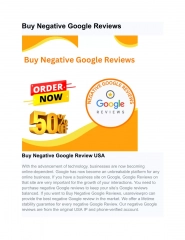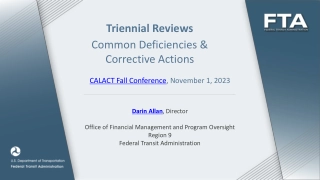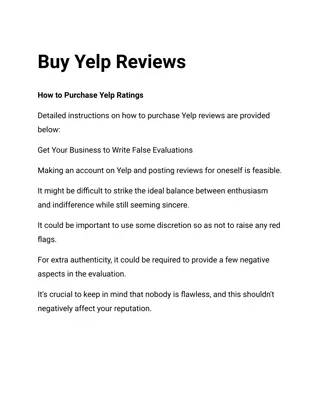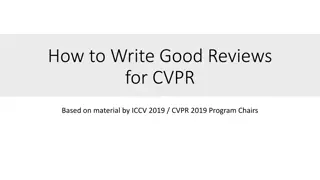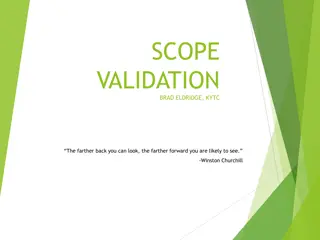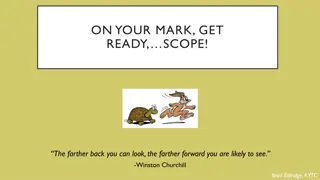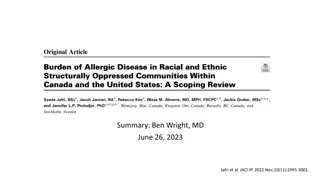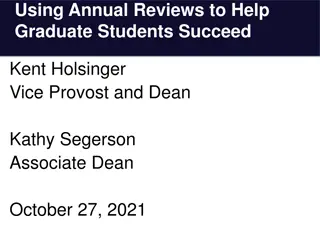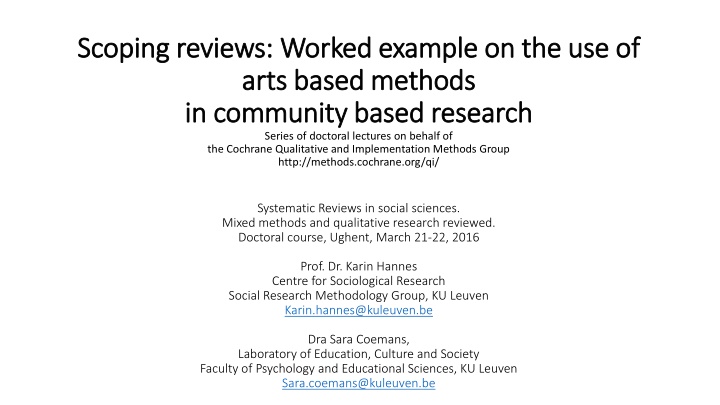
Conducting a Scoping Review on Arts-Based Research: Key Concepts and Framework
Explore the process of conducting a scoping review in arts-based research, including defining the research questions, identifying relevant studies, study selection, data charting, and result collation. Understand the reasons for undertaking a scoping review and the framework for its execution.
Download Presentation

Please find below an Image/Link to download the presentation.
The content on the website is provided AS IS for your information and personal use only. It may not be sold, licensed, or shared on other websites without obtaining consent from the author. If you encounter any issues during the download, it is possible that the publisher has removed the file from their server.
You are allowed to download the files provided on this website for personal or commercial use, subject to the condition that they are used lawfully. All files are the property of their respective owners.
The content on the website is provided AS IS for your information and personal use only. It may not be sold, licensed, or shared on other websites without obtaining consent from the author.
E N D
Presentation Transcript
Scoping Scoping reviews: reviews: W Worked orked example example on arts based based methods methods in community in community based Series of doctoral lectures on behalf of the Cochrane Qualitative and Implementation Methods Group http://methods.cochrane.org/qi/ on the the use use of of arts based research research Systematic Reviews in social sciences. Mixed methods and qualitative research reviewed. Doctoral course, Ughent, March 21-22, 2016 Prof. Dr. Karin Hannes Centre for Sociological Research Social Research Methodology Group, KU Leuven Karin.hannes@kuleuven.be Dra Sara Coemans, Laboratory of Education, Culture and Society Faculty of Psychology and Educational Sciences, KU Leuven Sara.coemans@kuleuven.be
3. Scoping review Definition Definition s scoping coping review review exploratory projects to systematically map the literature available on a topic identifying the key concepts, theories, sources of evidence when the potentially relevant literature is thought to be vast and diverse not enough literature exists the systematic selection, collection and summarization of existing knowledge in a broad thematic area Canadian Institute of Health research
3. Scoping review Reasons Reasons to to undertake undertake a a scoping scoping review: review: 1. To examine the extent, range and nature of research activity 2. To determine the value of undertaking a full systematic review 3. To summarise and disseminate research findings 4. To identify research gaps in the existing literature
3. Scoping review Framework Framework for for conducting conducting a a scoping scoping review review 1. Identifying the research question(s) 2. Identifying relevant studies 3. Study selection 4. Charting the data 5. Collating, summarizing and reporting the results
4. 4. Conducting Conducting a scoping review a scoping review of arts of arts- -based research based research
4. Conducting a scoping review of arts-based research A. A. Identifying Identifying research research questions questions What is known from the existing literature about the use of arts-based methods in working with vulnerable communities? What are the given rationales for using arts based methods in working with vulnerable communities? What type of arts-based methods are common used? How do the authors of the articles describe arts-based methods? What do they describe as the added value and limitations of these arts based methods? Are the findings of the research projects in line with their purposes?
4. Conducting a scoping review of arts-based research A. A. Identifying Identifying research research questions questions Defining terms used in the review question : Arts-based methods: A research method in which the arts play a primary role in any or all of the steps of the research process. Art forms such as poetry, music, visual art, drama, and dance are essential to the research process itself and central in formulating the research question, generating data, analyzing data or presenting the research results. (Austin & Forinash, 2005) Intention to use art as a research method, to inform (arts-informed & arts-informing research), not as topic of research Active involvement in the artistic process, by the participant(s) and/or the researcher(s)
4. Conducting a scoping review of arts-based research A. A. Identifying Identifying research research questions questions Defining terms used in the review question Vulnerable: Those who are impoverished, disenfranchised, and/or subject to discrimination, intolerance, subordination and stigma (Nyamathi, 1998) e.g.: Ethnic communities, minority groups, immigrants, homeless, refugees, Children, youth, elderly Women People with disabilities
4. Conducting a scoping review of arts-based research A. A. Identifying Identifying research research questions questions Defining terms used in the review question Community: Communities can be broad defined: geographically (defined through psychical location), common cultural heritage, language, common beliefs, shared interest, (Israel et al.,1998) The community has to be active involved in the research project To recognize community as a unit of identity there has to be a shared interest: a state of common concern or curiosity to something, a topic of importance for that community, a particular cause To raise awareness Reciprocal relationship
4. Conducting a scoping review of arts-based research B. B. Identifying Identifying relevant studies relevant studies Decisions about the coverage: 1993-2013 20 years Reason: arise of the term arts-based research in 1993 Decisions about the language of the articles: English
4. Conducting a scoping review of arts-based research B. B. Identifying Identifying relevant studies relevant studies Decisions about the search terms: Terms to capture topic of interest: arts-based, arts-informed, arts based , arts informed , visual research , visual method* , photo-voice, photo-elicitation, photo voice , photo elicitation , paint*, collage*, drama, danc*, music, theater, theatre, poetry, artefact*, story*, novel, sculpture*, Terms to capture population: youth, adolescent*, vulnerable, minorit*, oppressed, disempowered, disadvantaged, poverty, asylum seeker* , refugee*, homeless, . Terms to capture setting: communit*, neighbourhood*, .
4. Conducting a scoping review of arts-based research B. B. Identifying Identifying relevant studies relevant studies Literature search through different sources: Search strategy Websearch professional associations Electronic databases Handsearch journals Consultation experts Grey literature Reference lists SSCI, IBSS, SA, SSA, Francis, Eric
4. Conducting a scoping review of arts-based research B. B. Identifying Identifying relevant studies relevant studies Terms to capture topic of interest: search abstract Additional limits - Date: From 01 January 1993 to 31 December 2013 (SU.EXACT.EXPLODE("Visual arts") OR SU.EXACT.EXPLODE("Performing arts") OR SU.EXACT.EXPLODE("Fine arts")) OR ab("arts- based" OR "arts based" OR "arts-informed" OR "arts informed" OR "visual research" OR "visual method*" OR "photo-voice" OR "photovoice" OR "photo-elicitation" OR "photo elicitation" OR paint* OR collage* OR drama* OR danc* OR music OR theater OR theatre OR poetry OR poem* OR story* OR stories OR artefact* OR artifact* OR novel* OR sculpture*)
4. Conducting a scoping review of arts-based research B. B. Identifying Identifying relevant studies relevant studies Terms to capture population: search all fields Additional limits - Date: From 01 January 1993 to 31 December 2013 SU.EXACT.EXPLODE("Adolescence") OR SU.EXACT.EXPLODE("Youth") OR SU.EXACT.EXPLODE("Migrants") OR SU.EXACT.EXPLODE("Poverty") OR SU.EXACT.EXPLODE("Refugees") OR SU.EXACT.EXPLODE("Asylum seekers") OR SU.EXACT.EXPLODE("Minorities") OR women OR marginalized OR vulnerabl* OR "low income" OR poor OR homeless OR oppressed OR disempowered OR disadvantaged OR underserved OR unemployed OR underemployed OR "low skilled" OR "low- skilled"
4. Conducting a scoping review of arts-based research B. B. Identifying Identifying relevant studies relevant studies Terms to capture setting: search all fields Additional limits - Date: From 01 January 1993 to 31 December 2013 (SU.EXACT.EXPLODE("Community participation") OR SU.EXACT.EXPLODE("Community power") OR SU.EXACT.EXPLODE("Community") OR SU.EXACT.EXPLODE("Community development") OR SU.EXACT.EXPLODE("Community care")) OR (communit* OR "community-based" OR "community based" OR neighbourhood*))
4. Conducting a scoping review of arts-based research B. B. Identifying Identifying relevant studies relevant studies Combination of terms: ((SU.EXACT.EXPLODE("Visual arts") OR SU.EXACT.EXPLODE("Performing arts") OR SU.EXACT.EXPLODE("Fine arts")) OR ab("arts-based" OR "arts based" OR "arts-informed" OR "arts informed" OR "visual research" OR "visual method*" OR "photo-voice" OR "photovoice" OR "photo-elicitation" OR "photo eliciation" OR paint* OR collage* OR drama* OR danc* OR music OR theater OR theatre OR poetry OR poem* OR story* OR stories OR artefact* OR artifact* OR novel* OR sculpture*)) AND (SU.EXACT.EXPLODE("Adolescence") OR SU.EXACT.EXPLODE("Youth") OR SU.EXACT.EXPLODE("Migrants") OR SU.EXACT.EXPLODE("Poverty") OR SU.EXACT.EXPLODE("Refugees") OR SU.EXACT.EXPLODE("Asylum seekers") OR SU.EXACT.EXPLODE("Minorities") OR women OR marginalized OR vulnerabl* OR "low income" OR poor OR homeless OR oppressed OR disempowered OR disadvantaged OR underserved OR unemployed OR underemployed OR "low skilled" OR "low-skilled") AND ((SU.EXACT.EXPLODE("Community participation") OR SU.EXACT.EXPLODE("Community power") OR SU.EXACT.EXPLODE("Community") OR SU.EXACT.EXPLODE("Community development") OR SU.EXACT.EXPLODE("Community care")) OR (communit* OR "community-based" OR "community based" OR neighbourhood*)) = 1061 hits
4. Conducting a scoping review of arts-based research B. B. Identifying Identifying relevant studies relevant studies Database Date Searched Number Retrieved After Duplicate Removal Social Sciences Citation Index (SSCI) 19 February 2014 2,482 International Bibliography of the Social Sciences (IBSS) 19 February 2014 1061 Sociological Abstracts (SA) 19 February 2014 1525 Social Services Abstracts 19 February 2014 325 Francis 19 February 2014 657 Eric 19 February 2014 1,713 Total 7763 6750
4. Conducting a scoping review of arts-based research B. B. Identifying Identifying relevant studies relevant studies Use of the bibliographic software package Endnote to manage the records, keeping track of articles,
4. Conducting a scoping review of arts-based research C. C. Study Study selection selection Identification of inclusion and exclusion criteria To ensure consistency in decision-making Developed post hoc
4. Conducting a scoping review of arts-based research C. C. Study Study selection selection Exclusion criteria: Inclusion criteria: - Language: other languages will be excluded - Interest: non-artistic methods, art therapy, art as the topic of research to understand the art itself (arts- based inquiry) - Population: not vulnerable - Setting: individual level - Field of interest: health - Design: commentaries, papers, (book) reviews; books; theoretical papers, research, methodological papers, quantitative. - Language: English - Interest: artistic medium as a keyword or focus in the abstract (arts-informed and arts- informing inquiry) - Population: the participants can be called vulnerable - Setting: Community level - Field of interest: pedagogy opinion - Design: qualitative, primary research evaluative
4. Conducting a scoping review of arts-based research C. C. Study Study selection selection Three-step strategy for screening the studies: Initial screening by one reviewer: to quickly determine whether a study might be appropriate for the review based on the study s title. Second screening by two reviewers, independently: screening the abstract and bibliographic information against inclusion and exclusion criteria to determine whether these studies should remain in the review. Disagreements were solved by discussion with a third reviewer. Thirdscreening: (strict) screening of full copies of the articles (that are labelled include or unclear )
4. Conducting a scoping review of arts-based research C. C. Study Study selection selection second screening second screening
4. Conducting a scoping review of arts-based research D. D. Charting Charting the data the data Charting = technique for synthesising and interpreting qualitative data by sifting and sorting material according to key issues and themes (Ritchie & Spencer, 1994) Characteristics of the studies Pheno- menon Year of publication Country Setting Partici- pants sample Team Author s discipline Research design
4. Conducting a scoping review of arts-based research D. D. Charting Charting the data the data Analytical categories Purpose of the study Rationale for using arts Methods Datacollection Methods Data-analysis Methods Dissemination Findings Main Conclusion Strengths Limitations Guidelines/ challenges
4. Conducting a scoping review of arts-based research E. E. Collating Collating, , summarizing summarizing and results results and reporting reporting the the Basic numerical analysis & cross-case analysis In which countries where the studies conducted? Which methods for datacollection/data-analysis/dissemination are commonly used, and for which population? What rationales for using arts-based methods did they mention? Which research designs are often used? Do they call their research arts-based research and in which circumstances? ....
4. Conducting a scoping review of arts-based research Strengths Strengths of of scoping scoping review review It provides a rigorous and transparant method for mapping areas of research Reviewers are in position to illustrate the field of interest in terms of the volume, nature and characteristic of primary research This analysis makes it possible to identify gaps, as well as summarising and disseminating research findings
4. Conducting a scoping review of arts-based research Challenges Challenges Iterative process Quantity of data generated was considerable, how far is breadth of the review more important than depth? Lack of detailed info in the abstracts Creative titles Still very time-consuming

